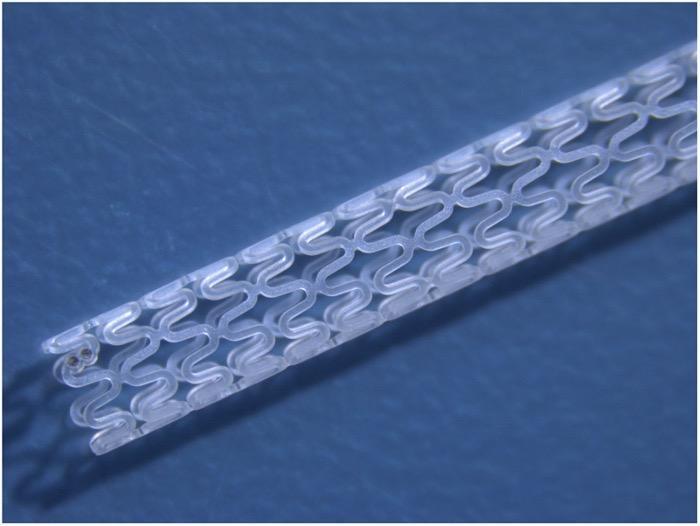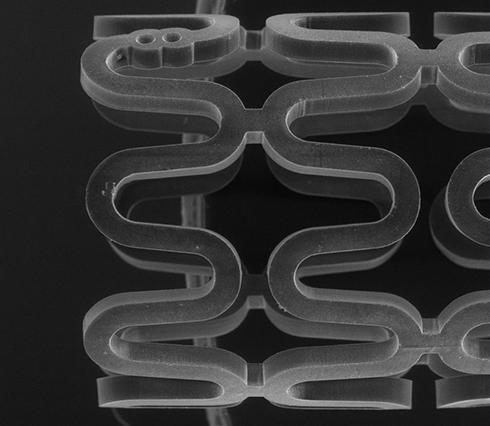From heart stents to household pipes - how advanced polymers are set to transform the ‘plumbing’ in our bodies and our homes
In the near future, heart patients who require a stent could be fitted with tiny tubes made of advanced polymers that later dissolve harmlessly into the body.
The technology behind this remarkable invention - which has passed all pre-clinical trials and is due to undergo human trials soon - was developed at the University of Bradford’s Polymer Interdisciplinary Research Centre (Polymer IRC).
If approved, this cutting edge technology will vastly improve health outcomes for thousands of people, because while metal stents are useful, they also come with problems, in that they can lead to blood clots.
The polymer stents are ‘bioresorbable’, which means they eventually dissolve harmlessly into the body. They are being developed by Leeds-based Arterius under the trade name Arteriosorb.
Professor Phil Coates - alongside Dr Fin Caton-Rose and technical officer Glen Thompson - from the Faculty of Engineering & Informatics, has worked in polymer research for over 40 years and says the technology has huge potential.
“Plastics have a bad press at the moment,” he says. “But here is an example of a plastic that’s useful to us, saves lives, and does not harm the environment. We’re very excited about the possibilities of bioresorbable stents, because they have many advantages over metal ones.

Professor Phil Coates
“Metal stents can cause problems, such as thrombosis (or blood clotting) and once you insert a metal stent, you cannot then remove it, as it will tear the arterial wall. Polymer stents are just as strong and engineered to a thickness that will not impede blood flow.”
A spokesperson for Arterius, which has invested over £7m in product development, said: “The collaboration with the Bradford team has made it possible to develop a class-leading bioresorbable coronary stent with superior radial properties using a controlled precision manufacturing process, opening the way for the next-generation of arterial stents.”
Clinical trials of 40 patients at four UK hospitals were due to begin in 2019 but these were delayed by the pandemic - they are due to resume shortly.
The Polymer IRC is also using the same expertise in advanced polymer research to create lightweight, high performance pipes that can be used in plumbing. These will create an alternative to copper pipes, which are expensive and have a negative environmental impact.

The polymer bioresorbable coronary stent
Here is an example of a plastic that’s useful to us, saves lives, and does not harm the environment. We’re very excited about the possibilities of bioresorbable stents, because they have many advantages over metal ones.
Professor Phil Coates
Major global polymer manufacturer, SABIC (Saudi Basic Industries Corporation) is working with the University and says it aims to take a 20 per cent market share by 2030, using polymer pipes, which typically outperform current pipes in every way.
Prof Coates says: “We have developed the technology to take a quite ordinary plastic and transform it by molecular orientation into something with quite extraordinary properties. With SABIC, we are taking polyethylene and polypropylene to make domestic pipes that need to withstand high water pressure, which perform 20 per cent better in every direction than existing pipes on the market.”

The polymer stent viewed under a microscope
A spokesperson for SABIC, which has invested £3m in research and development, said: “We succeeded in producing polypropylene and polyethylene pipes with MRS values up to 15 [minimum standard is 8]. This is an enormous improvement on what could be achieved with SABIC’s resins to date, and much better than any product on the market.”
Both products exploit what is called ‘biaxial orientation’ of polymers (biaxial = lining up internal structures to enhance properties, in this case to hold tubes open against various pressures) – this is a remarkable property of polymers that they can have their structure transformed so effectively – and it is also very cost-effective.
